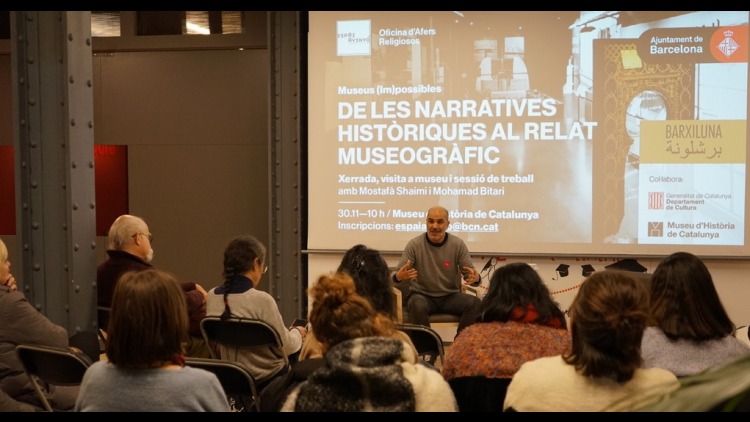ISLAM | #Barxiluna “Museums are an expression of nationhood, of politics; they legitimise discourses of power, but they are also a battlefield”, Mostafà Shaimi
“Barxiluna برشلونة: a (forgotten) Muslim past and present" is a set of activities that emphasise Barcelona’s Muslim legacy and how it has influenced the city. The second activity in this programme, organised by Espai Avinyó - Language and Culture, the Office of Religious Affairs and the Museum of the History of Catalonia, was a new edition of the “(Im)possible Museums” series, a specific initiative from Espai Avinyó. The activity took place on Thursday 9 February of 2023 at the Museum of the History of Catalonia.
The Museum of the History of Catalonia first opened its doors in February 1996. Unlike other museums, it was not born from the need to exhibit an already existing collection. Instead, it was created to lead the way in the dissemination of Catalonia’s collective heritage and history. Among the activities included in “Barxiluna برشلونة: (Dis)memory of the Islamic Past and Present” (#Barxiluna), and taking into account the nature, aims and museographic narrative of the museum’s collection, a space for reflection and work was established to jointly analyse different facets of dissemination, history, heritage, the treatment of the “other”, narratives, museography, relationships, etc.
This #Barxiluna activity, set within the framework of the series “(Im)possible museums” (Espai Avinyó) (Spanish) in format and content, has generated different educational spaces for intercultural reflection by visitors, rethinking and broadening the perspective of Western imaginaries of cultural diversity, which are present in the exhibition programmes offered by the city’s exhibition halls, cultural centres, local facilities and museums.
The encounter “(Im)possible museums: From historical narratives to museographic narrative” was a space for reflection, dialogue and collaborative work to discuss the transmission of the memory of the Islamic past and present at the Museum of the History of Catalonia. Thinker and teacher Mostafà Shaimi and poet and translator Mohamad Bitari were invited to the activity, to reflect on how the museum’s museographic narrative is shaped in relation to the way the Islamic legacy is narrated as part of the history of Catalonia.
The first part of the activity consisted of putting some key questions on the table about the dialectics generated at the beginning when the Museum of the History of Catalonia was created – what did the desire to have a museum like this one stem from? or what was it in confrontation with? What does this tell us about the museographic content of the museum? With these questions in mind, Mostafà Shaimi commented that “museums are the maximum expression of nationhood, of politics, an institution that legitimises discourses of power, and one that can also become a battlefield”.
This was followed by other questions posed from a philosophical, historiographical and political point of view. In response to these questions, Mostafà Shaimi suggested that we ask ourselves: 1) How do the homeland, the nation and the state instrumentalise religion and race to create an “otherness” that is deemed to be inferior? 2) How can we rethink this “otherness” in relation to what it is to be Catalan, and Catalan nationalism? In other words, how can we push aside the mythical, imagined vision of what it means to be Catalan?
It was concluded that religious racism, evidenced in the dehumanisation and expulsion of the “Muslim other” and the “Jewish other” from the Iberian peninsula, explain the symbolic and material conflicts that determine the construction of the identity of the Spanish and Catalan “race”. The rhetoric of the Reconquista, of the enemy, and of the denial of Islamic and Jewish identities explain the racism present in the political institutions and disciplines in charge of the production of knowledge in this field.
Subsequently, within this framework of reference there was a visit to the Museum of the History of Catalonia’s permanent exhibition, during which poet Mohamad Bitari recited his poem “Malediction of the Earth”:
It is we, suspended between you and the Earth,
and our longing has roots like a tree, ancient,
like a tangle of clouds trembling
over the verdigris of the cement.
After these moments of reflection and awareness, there was a debate, which led to a number of proposals, reformulations and ideas for rethinking the museum’s narrative. Firstly, the museum could learn from feminist epistemology and situated knowledge, and in this way, tell stories that generate dialogue with the people who are closest to those stories. And that is why it is necessary to have recourse to people and specialists with a more finely tuned and nuanced view of these stories. Secondly, for these stories marginalised by the official narrative to form an organic part of the museum, it would be necessary to stop talking about “history” in the singular and instead talk about “histories” in the plural, and for the museum to “offer different histories for visitors to discover and reflect on”. Thirdly, the museum should be thought of as a repository for the history of structural racism in Catalonia, and from this starting point, a local and self-critical form of anti-racism should be developed. In fourth place, there would be a need to reflect on the idea of museography as untouchable, which implies thinking about very specific changes to the narratives that do not involve too great an expenditure, and also a rethinking of the way in which budgets are prioritised. And finally, we should be open to the possibility of designing museographies that are more versatile and are permeable to the diverse narratives that emerge.

